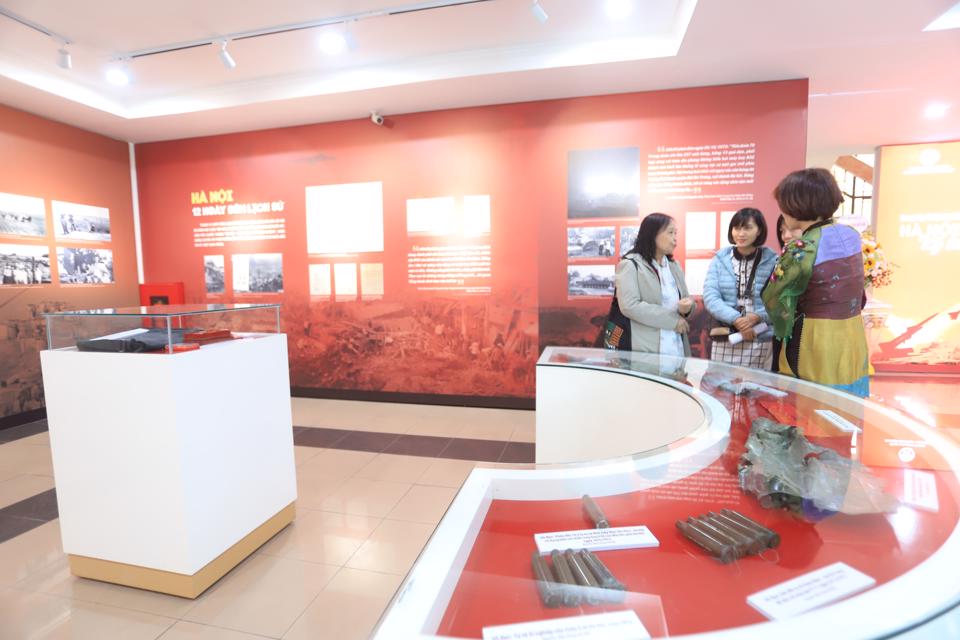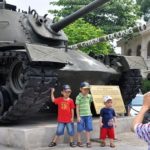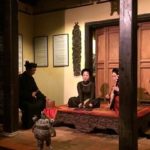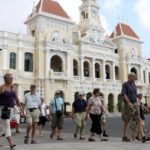A month-long exhibition telling the story of Vietnamese resilience, creativity, and bravery in a 12-day air defense against the US troops was launched on December 5.
| The exhibition on the victory of “Dien Bien Phu in the air” opens to the public. Photo: Lai Tan/The Hanoi Times |
The exhibition, entitled “Hanoi, the memory of 12 days and 12 nights – The victory of Dien Bien Phu in the air”, is part of a series of activities organized to celebrate the 50th anniversary of the victory against the US airforce in December 1972.
The campaign, widely known as “Dien Bien Phu in the Air,” was a defense operation launched by the Vietnam Air Force and ground-based air defense against US air raids by B52 bomber – the most modern aircraft of the time – on Hanoi and neighboring cities and provinces.
The operation lasted 12 days and nights, from December 18 to 30, 1972, and resulted in the victory of the Vietnamese, which was attributed to the leadership of the Party and the Government and the courage, endurance, and patriotism of the authorities and the people of Hanoi and other northern localities.
In such a period, northern Vietnam suffered a total of 80,000 tons of bombs and shells. In Hanoi alone, US aircraft dropped more than 10,000 tons of bombs, destroyed and damaged some 17,000 houses, and set fire to an area of 100,000 square meters (m2).
However, the Hanoians and army shot down 23 B52 bombers and two F111 aircraft and captured 43 pilots alive, marking the great victory of Vietnamese air defense against US aircraft.
This important victory strengthened the Vietnamese conviction to achieve complete independence and unification and gave Vietnam the upper hand in negotiating peace.
More than 80 objects, in the form of reading material, artifacts, and photos, are on display, grouped in three parts.
The first part tells how the leadership and people prepared the city for battle, evacuating residents and public property to rural areas, constructing the firepower network, and establishing fire and medical units.
The other two parts describe the destruction caused by the US bombing, the resistance of the people and militia of Hanoi, and the results in the city’s defense and the increase in economic production.
Major General Pham Tuan, the first pilot to shoot down the B52 bomber, said that during that battle, everyone remained focused and determined to achieve victory. “The victory was the result of the collective power brought by all the people and soldiers using various weapons,” he said.
| Delegates visit a section displaying materials and photos about the 12-day air defense campaign in December 1972. Photo: Lai Tan/The Hanoi Times |
The major general said the Vietnamese Air Force began learning to shoot down B52 bombers long before the battle, but in practice, doing so was much more difficult, as the bombers had a signal jamming device and were protected by many fighters.
Faced with difficulties, Vietnamese pilots decided to attack the flanks of US fleets at high speed without using radar or other electronic devices, he said, emphasizing that this made their job “twice as difficult.”
Colonel Nguyen Dinh Kien said that his ground-to-air missile battalion shot down four B52 bombers in the 12 days and night event.
Missile soldiers were quick learners, and they had enough experience fighting against aircraft and bombers, thus, all missile units were very confident about victory, he said.
During the battle, Hanoi’s missile units shot down 16 B52 bombers, Kien said.
His battalion fought 21 engagements and shot down four bombers, he said, adding that his battalion was one of the two best fighter units.
Painter Ngoc Linh, 93, said he was so moved by the exhibition that all the memories of those days came back to him like a movie. “I am happy that the proofs of a historical time in Hanoi are preserved with honor so young generations can learn from the past.”
Attending the exhibition, Ho Thi Loan, 24, from Nghe An province, said it is fortunate for her to see the achievements and glories of the previous generations. “Born in the world of peace, I must appreciate their efforts and results, love my country, and will never stop dedicating myself to making Vietnam better and better,” she noted.
Ancient house in Ma May
NDO – Ma May, a rare quarter that still retains several old houses, has created one of the characteristics of Hanoi. Hanoi’s streets are becoming increasingly crowded and traditional features can sometimes be hidden behind modern life. But if one takes the time to relax and look around, the ancient features begin to reveal themselves.










